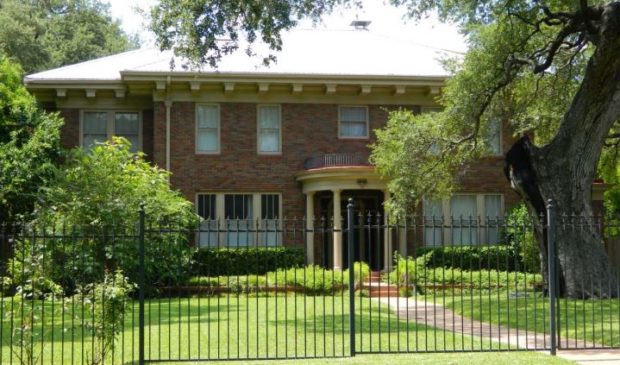Despite owners’ wishes, historic zoning advances
Tuesday, September 4, 2018 by
Jo Clifton Staff won a preliminary victory in its quest to zone a 1923 West Austin house historic against the owners’ wishes last week. The City Council vote was 6-3, but with two members off the dais and not voting, the final decision remains very much in doubt.
Council members Greg Casar and Delia Garza were absent during the hearing and vote. When the matter comes back for second and third readings, it will take nine of the 11 Council members to approve it because of two valid petitions.
Both the owners of the Bryson-Krueger-Critz House at 1602 West Lynn St. and their neighbors have separate valid petitions against the historic zoning, which is not the usual case.
Mayor Steve Adler joined Mayor Pro Tem Kathie Tovo and Council members Alison Alter, Ora Houston, Leslie Pool and Ann Kitchen in voting for the historic designation. However, Kitchen was quick to note that she was not convinced that the house should be landmarked and that she would need to be persuaded before second and third reading.
Council members Ellen Troxclair, Jimmy Flannigan and Pio Renteria voted no. Their missing colleagues seem likely to vote against the historic zoning under the circumstances.
New homeowner Jay Riskind said he and his wife want to have a large family and to be able to accommodate members of their extended family when they come to visit. Currently, the house is about 3,500 square feet. At first, Riskind said, they planned to double the size of the house, but now they plan to add about 2,000 square feet.
Riskind explained that the heritage trees on the property and the McMansion ordinance had limited how much they could expand the house. They took their plans to a committee of the Historic Landmark Commission, but the committee quickly rejected their plans and asked staff to begin the process of landmarking the house. (The HLC voted for historic zoning. There were not enough votes on the Zoning and Platting Commission to recommend historic designation.)
Historic Preservation Officer Steve Sadowsky told Council the 1923 house is a good example of the Italian Renaissance style, which flourished in Austin during the 1910s and 1920s. The house is a contributing structure in the Old West Austin National Register District, Sadowsky noted.
The original owners of the house were a cotton broker and his wife. Another important occupant of the house was attorney Richard Critz, who was an associate justice of the Texas Supreme Court in the 1930s and 1940s. In addition to his service on the court, Critz assisted Williamson County District Attorney Dan Moody in prosecuting members of the Ku Klux Klan. Moody later served two terms as governor.
According to the Texas State Historical Association online, “Critz’s judicial opinions are noteworthy for unusual conciseness and clarity, as well as for their logic and numerical abundance. He helped establish a judicial pattern for regulating the oil industry and was influential in the development of the substantial-evidence rule.”
Although Sadowsky praised the house, architectural historian Cherise Bell, who was hired by the Riskinds, told Council that the home is, in fact, a poor example of the Italian Renaissance Revival style. She pointed to the metal roof, which should be red clay tile, as well as changes previous owners have made, including a modern garage door, as good reasons not to landmark the house.
Glen Coleman, who represented the Riskinds, pointed out that the house at 2 Niles Road is a superior example of the Italian Renaissance style, but it has not been landmarked.
Coleman also said that the city, the county and the school district would lose about $100,000 if the house were landmarked. “If you decide to landmark this property, you’ll be giving a tax break to a fairly well-to-do couple in West Austin – who absolutely doesn’t want it – in the amount of over $100,000 over the next 12 years,” he said.
Tovo, who generally supports historic zoning, pointed out that no one who owns a historic house is required to apply for the tax break associated with it. Flannigan took issue with the idea that it would be appropriate to forgo the tax exemption.
The Riskinds requested a partial demolition permit for their plan to add a half-story to the home, creating a line of dormers, replacing the windows and changing the front portico and adding additions to the side.
Sadowsky said the changes the Riskinds wanted to make would eliminate the house as a contributing structure in the historic district. The changes would also prevent any future owner from landmarking the house, he said.
Troxclair suggested that there should be some middle ground between what the Riskinds want and what historic preservationists want. But since the preservationists want no changes to the front of the house and the homeowners have been struggling to work with other city regulations also, that seems like a difficult path.
Photo courtesy of the city of Austin.
The Austin Monitor’s work is made possible by donations from the community. Though our reporting covers donors from time to time, we are careful to keep business and editorial efforts separate while maintaining transparency. A complete list of donors is available here, and our code of ethics is explained here.
You're a community leader
And we’re honored you look to us for serious, in-depth news. You know a strong community needs local and dedicated watchdog reporting. We’re here for you and that won’t change. Now will you take the powerful next step and support our nonprofit news organization?











